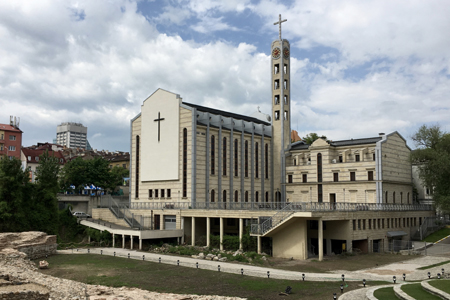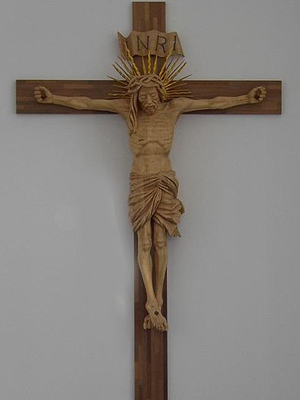| |
 |
 |
 |
| Comment on this report, or find other reports. |
 |
| Our Mystery Worshippers are volunteers who warm church pews for us around the world. If you'd like to become a Mystery Worshipper, start here. |
 |
| Find out how to reproduce this report in your church magazine or website. |
|
|
| 3166: St Joseph's Cathedral, Sofia, Bulgaria |
 |
 |
 |
Mystery Worshipper: Columba's Currach.
The church: St Joseph's Cathedral, Sofia, Bulgaria.
Denomination: Roman Catholic, Diocese of Sofia and Plovdiv. The parish is under the care of the Order of Friars Minor Capuchin.
The building: The original building was destroyed in an allied bombing raid during the Second World War. No replacement was built during the period of communist rule. Pope John Paul II laid the foundation stone for the current building in 2002, and it was finished in 2006. It's a striking modern building with Gothic influences. The interior is dominated by an enormous wooden crucifix that features a Christ who looks far more like a Palestinian manual labourer than is common in conventional depictions (although in my opinion, he also looks to be rather more than 33 years old). This is flanked on either side of the sanctuary by large wooden sculptures of St Joseph and St Francis of Assisi. The final focal point is an icon of the Virgin Mary, given by Patriarch Maxim of Bulgaria for the church's dedication.
The church: Roman Catholics are a tiny minority in Bulgaria, constituting rather less than one per cent of the population. Despite, or perhaps because of, their small numbers, the parish in Sofia seems to be a hive of activity. They host three communities of the Neocatechumenal Way, a group of Third Order Franciscans, and a branch of the conservative Italian Catholic group Comunione e Liberazione. Nineteen masses are said each week, including eight each Sunday. Of the Sunday masses, four are in Bulgarian and one each in Latin, English, Polish and French. An additional mass is also said in Italian each month. Catechism classes are taught for children in Bulgarian and Polish, and for adults in Bulgarian and English.
The neighbourhood: Bulgaria is a very homogenous society religiously, but you would not necessarily guess it from this neighbourhood of Sofia. Within a few minutes' walk of the Roman Catholic cathedral, one can find a massive Sephardic synagogue (the largest in the Balkans), Sofia's only functioning mosque, an Armenian church, as well as Romanian, Russian, and of course Bulgarian Orthodox churches. The young and liberal in Sofia are understandably proud of this coexistence, given that the Balkans have not recently been particularly associated with peaceful coexistence amongst religious and ethnic groups. One young Sofian told me that this neighbourhood is proof that "if you live a stone's throw away, then you can't afford to throw stones."
The cast: The service was led by a Capuchin friar, assisted by a server/lector. A second friar appeared to help distribute communion, and also to make announcements at the end. None of these were named.
The date & time: 7 May 2017, 12.00pm.
What was the name of the service?
Mass in Latin.
How full was the building?
Not very full. The cathedral can apparently hold 1000, but there were perhaps 20 there when the mass began, with more trickling in, leading to a total of about 40 by the distribution of communion.
Did anyone welcome you personally?
Not in the church building itself. But when I was waiting outside, a friar smiled at me and said hello.
Was your pew comfortable?
The pew was fine, the kneeler less so.
How would you describe the pre-service
atmosphere?
Quiet and reverent.
What were the exact opening words of the
service?
The server/lector said something in Bulgarian that I didn't understand. I think it may have been the mass intention. The first words spoken by the priest were: "In nomine Patris, et Filii, et Spiritus Sancti."
What books did the congregation use during the
service?
We had the most wonderful polyglot paperback missal. I've come across bilingual Latin-English and Latin-French mass booklets in Europe, as well as English-Spanish ones in the US, but this made those look like strictly amateur productions. It had no fewer than twelve columns, giving the order of mass in Latin, Bulgarian (Cyrillic), Bulgarian (transliterated), Italian, English, French, Spanish, German, Slovak, Croatian, Polish, and Russian. There were also copies of the readings (but sadly not the psalm) available in most, if not all, of these languages.
What musical instruments were played?
An organ. I didn't see any pipes, so it must have been electric, but it sounded quite impressive nonetheless.
Did anything distract you?
Remarkably little, really, given that this was a strange church in a strange land. Two mobile phones went off. A dodecalingual mass booklet should have been distracting, but it was mostly laid out in a very clear order. There was, however, one significant misprint in the Latin version of the Sursum corda. It took me a moment to remember what the correct response to Gratias agamus Domino Deo nostro was, by which point everyone else had already responded (correctly).

Photo:
© Vassil Makarinov and used under license
Was the worship stiff-upper-lip, happy clappy, or
what?
Fairly typical Catholicism, without any great ceremony or fuss, but celebrated perhaps more slowly and solemnly than one would typically find in an Anglophone parish.
Exactly how long was the sermon?
I have to admit that I forgot to time it exactly, but it was certainly no more than five minutes.
On a scale of 1-10, how good was the preacher?
6 – I didn't understand the Bulgarian sermon, but the priest seemed to have a good rapport with his flock. The meditation printed on the English language mass sheet was good, if not ground-breaking.
In a nutshell, what was the sermon
about?
I can't judge the Bulgarian sermon. But the printed English language meditation, written by the Vienna International Religious Centre, was about the role of the shepherd image in the Bible. God is the shepherd of the people of Israel, and this idea finds its perfect fulfillment in the image of Christ as shepherd of all. This, we were assured, is not a saccharine or sentimental image, but an earthy one speaking to the very real needs of people.
Which part of the service was like being in
heaven?
The wonderfully cosmopolitan nature of the congregation. In the pew in front of me were a Bulgarian teenager and a Japanese woman of advanced age. Behind me were three men from Anglophone Africa. As I left, I heard the distinct sound of Irish-accented English. And am I fairly certain the man across the aisle from me was Romani, a member of a group that still suffers from appalling prejudice in Bulgaria. All were united in the holy sacrifice of the mass – just like the author of Revelation foresaw when he wrote of a multitude of diverse "kindreds, and people, and tongues" standing before the throne of the Lamb.
And which part was like being in... er... the other place?
Three things, in ascending order of seriousness. My kneeler was quite uncomfortable. The congregation didn't join in singing the mass setting, and the organ overwhelmed the cantor. This meant I couldn't really hear the words of the Creed and didn't know when to bow, etc. Finally, there was a fairly strict summary of who could and could not receive communion, accompanied by an explanation that Roman Catholics could, in extremis, receive the sacraments from an Orthodox priest. I don't blame the parish for reiterating the teachings of the magisterium, but our broken communion is certainly a taste of the "other place" on earth.
What happened when you hung around after the service looking lost?
Everyone went their several ways, although I suspect mostly to lunch.
How would you describe the after-service
coffee?
There was none.
How would you feel about making this church your regular (where 10 = ecstatic, 0 = terminal)?
8 – If I lived in Sofia, I would probably attend this mass or the English language mass, except when there was an Anglican eucharist, which there is only once a month. The Anglican congregation, served from the chaplaincy in Bucharest (a five-and-a-half-hour drive to the northeast), meets in a building owned by St Joseph's, so I would definitely be spending time here!
Did the service make you feel glad to be a
Christian?
Very much so.
What one thing will you remember about all this in seven days' time?
The wonderfully diverse and polyglot congregation. |
|
|
 |
 |
 |
| We rely on voluntary donations to stay online. If you're a regular visitor to Ship of Fools, please consider supporting us. |
 |
 |
 |
| The Mystery Pilgrim |
 |
| One of our most seasoned reporters makes the Camino pilgrimage to Santiago de Compostela in Spain. Read here. |
 |
 |
 |
| London churches |
 |
| Read reports from 70 London churches, visited by a small army of Mystery Worshippers on one single Sunday. Read here. |
| |
|
|
|
|


